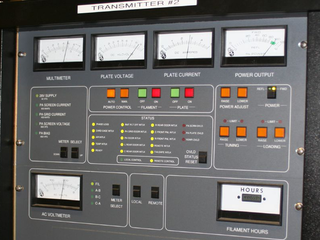
In telecommunications, a repeater is an electronic device that receives a signal and retransmits it. Repeaters are used to extend transmissions so that the signal can cover longer distances or be received on the other side of an obstruction. Some types of repeaters broadcast an identical signal, but alter its method of transmission, for example, on another frequency or baud rate.

In electronics and telecommunications, a radio transmitter or just transmitter is an electronic device which produces radio waves with an antenna with the purpose of signal transmission up to a radio receiver. The transmitter itself generates a radio frequency alternating current, which is applied to the antenna. When excited by this alternating current, the antenna radiates radio waves.
International broadcasting consists of radio and television transmissions that purposefully cross international boundaries, often with then intent of allowing expatriates to remain in touch with their countries of origin as well as educate, inform, and influence residents of foreign countries. Content can range from overt propaganda and counterpropaganda to cultural content to news reports that reflect the point of view and concerns of the originating country or that seek to provide alternative information to that otherwise available as well as promote tourism and trade. In the first half of the twentieth century, international broadcasting was used by colonial empires as a means of connecting colonies with the metropole. When operated by governments or entities close to a government, international broadcasting can be a form of soft power. Less frequently, international broadcasting has been undertaken for commercial purposes by private broadcasters.

NSS Annapolis, officially known as Naval Communications Station Washington, D.C. Transmitter or NavCommStaWashingtonDC(T), was a Very Low Frequency (VLF) and High Frequency (HF) transmitter station operated by the United States Navy.
A broadcast transmitter is an electronic device which radiates radio waves modulated with information content intended to be received by the general public. Examples are a radio broadcasting transmitter which transmits audio (sound) to broadcast radio receivers (radios) owned by the public, or a television transmitter, which transmits moving images (video) to television receivers (televisions). The term often includes the antenna which radiates the radio waves, and the building and facilities associated with the transmitter. A broadcasting station consists of a broadcast transmitter along with the production studio which originates the broadcasts. Broadcast transmitters must be licensed by governments, and are restricted to specific frequencies and power levels. Each transmitter is assigned a unique identifier consisting of a string of letters and numbers called a callsign, which must be used in all broadcasts.

Capas, officially the Municipality of Capas, is a 1st class municipality in the province of Tarlac, Philippines, and one of the richest towns in the province. The town also consists of numerous subdivisions and exclusive villages.

Microwave transmission is the transmission of information by electromagnetic waves with wavelengths in the microwave frequency range of 300 MHz to 300 GHz of the electromagnetic spectrum. Microwave signals are normally limited to the line of sight, so long-distance transmission using these signals requires a series of repeaters forming a microwave relay network. It is possible to use microwave signals in over-the-horizon communications using tropospheric scatter, but such systems are expensive and generally used only in specialist roles.

Mount Santa Rita was a facility of the United States Navy in Bataan, Philippines. It was the U.S. Naval Link Station (USNAVLINKSTA) within the Philippines. There were approximately 15 people that were permanently attached to this station at any given time, while there were also seven Marine guards who rotated every seven days. These Marine Guards were members of Alpha Company Marine Barracks, Subic Bay. Other than military personnel, there were Philippine nationals that worked there as well.

Naval Station San Miguel is an installation of the Philippine Navy located in Barangay San Miguel, San Antonio, Zambales, Philippines. The United States turned over the base to the Philippine government in 1992.
U.S. Naval Radio Facility Bagobantay was a communications facility of the United States Navy that was located in Quezon City, Philippines.

Camp O'Donnell is a current military base and former United States military reservation in the Philippines located on Luzon island in the municipality of Capas in Tarlac. It housed the Philippine Army's newly created 71st Division and after the Americans' return, a United States Army camp. During World War II, the reservation was used as a prisoner-of-war camp for Filipino and American soldiers captured by Japan during its successful invasion of the Philippines. About 60,000 Filipino and 9,000 Americans were housed at the camp. During the few months in 1942 that Camp O'Donnell was used as a prisoner-of-war camp, about 20,000 Filipinos and 1,500 Americans died there of disease, starvation, neglect, and brutality.

DZBB-TV is a television station in Metro Manila, Philippines, serving as the flagship of the GMA network. It is owned and operated by the network's namesake corporate parent alongside GTV flagship DWDB-TV. Both stations share studios at the GMA Network Center, EDSA corner Timog Avenue, Diliman, Quezon City, while DZBB-TV's hybrid analog and digital transmitting facilities are located at the GMA Tower of Power, Tandang Sora Avenue, Barangay Culiat, Quezon City and Digital SFN relay towers located at PBCom Tower in Makati City, Zen Towers in Manila, Antipolo City, and Angeles City, Pampanga.

The Capas National Shrine in Barangay Aranguren, Capas, Tarlac, Philippines was built by the Philippine government as a memorial to Allied soldiers who were interned at Camp O'Donnell at the end of the Bataan Death March during the Second World War.

Shortwave relay stations are transmitter sites used by international broadcasters to extend their coverage to areas that cannot be reached easily from their home state. For example, the BBC operates an extensive net of relay stations.

The Armed Forces of the Philippines Officer Candidate School, formerly known as the School for Reserve Commission, is a military school located at Camp O'Donnell, Capas, Tarlac for the Philippine Army Officer Candidate School; Fernando Air Base in Lipa City, Batangas for the Philippine Air Force Officer Candidate School; and Naval Station Leovigildo Gantioqui in San Antonio, Zambales for the Philippine Navy Officer Candidate School. It was established in the Philippines for training future officers of the Armed Forces of the Philippines (AFP).

Jim Creek Naval Radio Station is a United States Navy very low frequency (VLF) radio transmitter facility at Jim Creek near Oso, Washington. The primary mission of this site is to communicate orders one-way to submarines of the Pacific fleet. Radio waves in the very low frequency band can penetrate seawater and be received by submerged submarines which cannot be reached by radio communications at other frequencies. Established in 1953, the transmitter radiates on 24.8 kHz with a power of 1.2 megawatts and a callsign of NLK, and is one of the most powerful radio transmitters in the world. Located near Arlington, Washington, in the foothills of the Cascades, north of Seattle, the site has 5,000 largely forested acres (2,000 ha).

Radio is the technology of communicating using radio waves. Radio waves are electromagnetic waves of frequency between 3 hertz (Hz) and 300 gigahertz (GHz). They are generated by an electronic device called a transmitter connected to an antenna which radiates oscillating electrical energy, often characterized as a wave. They can be received by other antennas connected to a radio receiver, this is the fundamental principle of radio communication. In addition to communication, radio is used for radar, radio navigation, remote control, remote sensing, and other applications.
Naval Radio Transmitter Facility Aguada is a tall guyed radio mast erected by the United States Navy. It is used as a facility of the US Navy for ashore and U.S. and NATO ships, planes, and submarines operating at sea in areas of broadcast coverage near Aguada, Puerto Rico at 18°23′55″N67°10′38″W by using radio waves in the very low frequency range.

Radyo Pilipino Corporation, presently operating as Radyo Pilipino Media Group, is a Philippine broadcasting company owned by Lucky Star Holdings. Originally founded in 1924, it is the oldest radio network in the Philippines; its current incarnation was founded on June 25, 1985, by a consortium led by businessman-politician Eduardo Cojuangco Jr.

NAA was a major radio facility located at 701 Courthouse Road in Arlington, Virginia. It was operated by the U.S. Navy from 1913 until 1941. The station was originally constructed as the Navy's first high-powered transmitter for communicating with its bases across the U.S. and the Caribbean. During its years of operation NAA was best known for broadcasting daily time signals, however, it also provided a variety of additional services, using multiple transmitters operating on frequencies ranging from longwave to shortwave. The station also conducted extensive experimental work, including, in 1915, the Navy's first transatlantic transmission of speech.
















